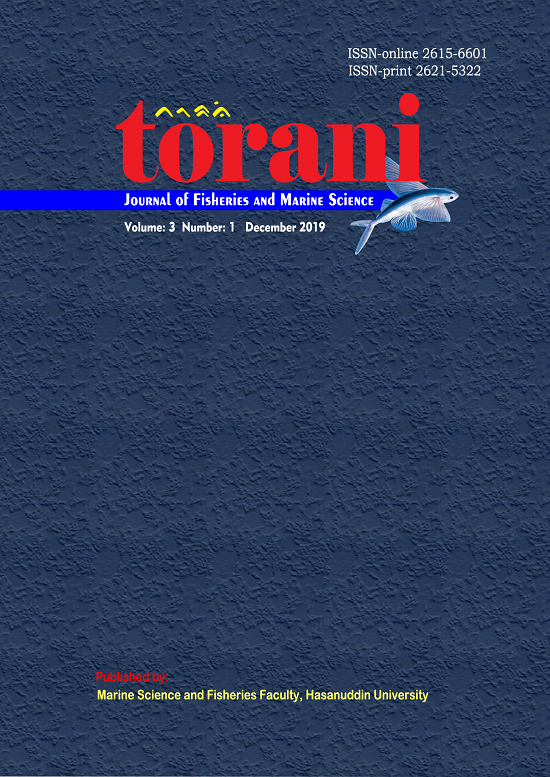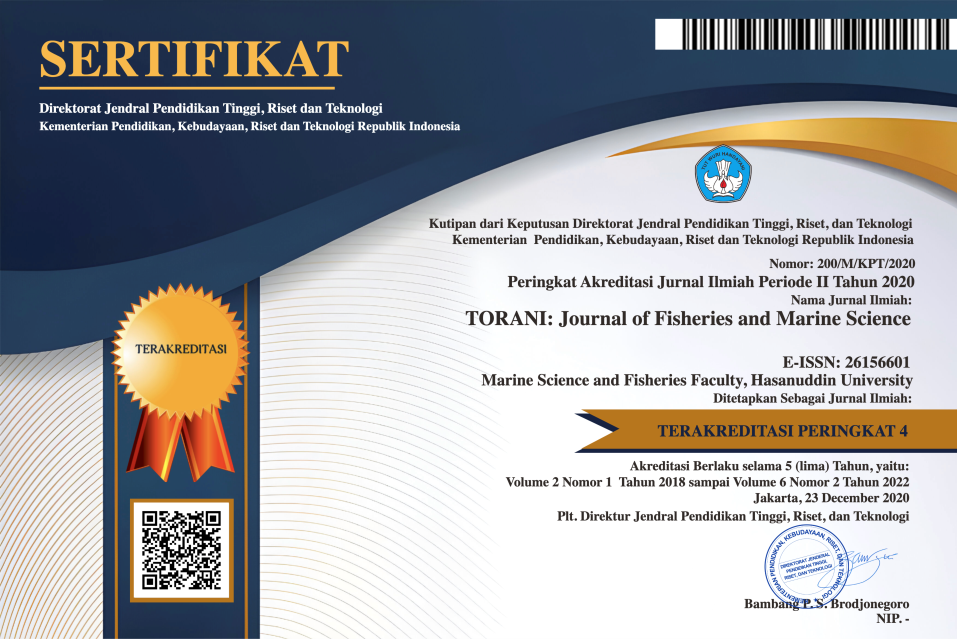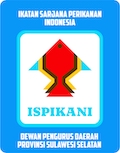The Utilization of Sweet Potatoes as Prebiotics on The Performance of Lactobacillus sp. in The Vanamei Shrimp Digestion (Litopenaeus vannamei)
DOI:
https://doi.org/10.35911/torani.v3i1.7241Abstract
The use of probiotics (Lactobacillus sp.) in feed is one alternative that is done to improve immunostimulants, growth stimulants, and can be used as a balance of microorganisms in digestion. This study aimed to evaluate the growth performance of vanamei shrimp fed with the addition of Lactobacillus sp. with sweet potatoes in feed. This study used a completely randomized design (CRD) with 4 treatments and 3 replications. The treatment was by feeding with different sweet potato concentrations: A) The dose of sweet potato in feed was 0% (as control); B) The dose of sweet potato in feed was 10%; C) 1The dose of sweet potato in feed was 15%; and D) The dose of sweet potato in feed was 20%. Data were analyzed using variance analysis (ANOVA) and continued with W-Tuckey's further test. The research parameters were digestive enzyme activity, nutrient digestibility, and growth. The results of the variance analysis showed the addition of various sweet potato concentrations with Lactobacillus sp. has no significant effect (p> 0.05) of the growth rate. The specific growth rate of vannamei shrimp ranges from 3.06 to 3.23% / day. Based on the results of the analysis on the utilization of sweet potatoes as a prebiotic on the performance of Lactobacillus sp. in the vannamei shrimps (Litopenaeus vannamei) digestive tract can be concluded that the growth performance does not have a significant effect after being fed with the addition of Lactobacillus sp. and sweet potatoes in feed.
Keywords: Enzymes, Digestion, Growth, Lactobacillus sp., Prebiotic, Probiotic.
References
Angelis, M. D. & Gobbetti, M. (2011). Lactic Acid Bacteria Lactobacillus spp General Characteristics. Encyclopedia of Dairy Sciences (Second Edition). 78–90.
Aslamyah, S. (2006). Penggunaan Mikroflora Saluran Pencernaan sebagai Probiotik untuk Meningkatkan Pertumbuhan dan Kelangsungan Hidup Ikan Bandeng. Disertasi. Progam Pascasarjana, Institut Pertanian Bogor.
Khasani, I. (2007). Aplikasi Probiotik Menuju Sistem Budidaya Perikanan Berkelanjutan. Media Akuakultur. 2(2): 86-90.
Lesmanawati, W., Widanarni, Sukenda, & Purbiantoro, W. (2013). Potensi Ekstrak Oligosakarida Ubi Jalar sebagai Prebiotik Bakteri Probiotik Akuakultur. Jurnal Sains Terapan Edisi III Vol-3 (1):21-25.
Marlis, A. (2008). Isolasi Oligosakarida Ubi Jalar (Ipomoea batatas L.) dan pengaruh Pengolahan terhadap Potensi Prebiotiknya. Tesis. Institut Pertanian Bogor. Bogor.
Mustafa, Y. (2017). Aplikasi Prebiotik Berbeda pada Pakan Terhadap Kinerja Bakteri Lactobacillus Sp. dalam Saluran Pencernaan Udang Vaname (Litopenaeus Vannamei). Tesis. Program Pascasarjana Universitas Hasanuddin.
Putra, A. N. (2016). Kajian Probiotik, Prebiotik Dan Sinbiotik untuk Meningkatkan Kinerja Pertumbuhan Ikan Nila (Oreochromis Niloticus). Tesis. Program Pascasarjana. Institut Pertanian Bogor. Bogor.
Suprapto. (2005). Petunjuk Teknis Budidaya Udang Vannamei (Litopenaeus vannamei). CV. Biotirta, Bandar Lampung.
Suri, R. (2017). Studi tentang Penggunaan Pakan Komersil yang Dicampur dengan Bakteri Bacillus coagulans terhadap Performa Litopenaeus vannamei. Skripsi. Universitas Lampung. Bandar Lampung.
Zainuddin, Abustang & Aslamyah, S. (2009). Penggunaan Probiotik pada Pakan Buatan untuk Pembesaran Udang Windu. Laporan Penelitian Hibah Kompetitif Prioritas Nasional. Universitas Hasanuddin. Makassar.















